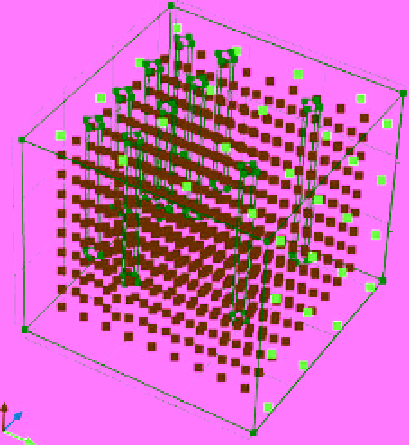Geoscience Reference
In-Depth Information
The inverse problem is
solved in the 7 steps
detailed below.
Step 1.
Kernel computation. First, we place
M
ele-
mentary dipoles (numbered from 1 to
M
), in a cubical
arrangement inside the three-dimensional COMSOL
Multiphysics model of the block, with coordinates (
x
,
y
,
z
) for each dipole. Next, we position
N
voltage monitoring
points on the two orthogonal surfaces of the block model.
These voltage monitoring points were placed with the
same positions and electrode numbers as the actual
measurement electrodes. Next, we computed the voltage
at each of the
N
monitoring points due to each of the
individual current densities at each of the
M
elementary
dipoles, separately. In each case, we subtracted the volt-
age at the position of the selected reference point. Indeed,
as explained in detail in Jardani et al. (2008), the com-
puted kernel must respect the voltage at the selected
reference electrode. In the resulting kernel matrix
configuration, the kernel is composed of three subma-
trices
K
=
K
x
,
K
y
,
K
z
, and each of these submatrices
K
i
i
=
x
,
y
,
z
is a
N
×
M
matrix so that
K
corresponds to
a
N
×3
M
matrix. Each of these submatrices represents
an orthogonal component of the leading field. In this rep-
resentation, each of the elementary dipoles used in the
computation is described by the electrical current dipole
moment vector,
m
d
=
I
D
, where
I
is the electrical current
magnitude,
D
represents the displacement vector that
points in the direction of the flow of the current (in the
direction of the electrical field), and
m
d
stands for the
electrical current dipole moment vector (this is equiva-
lent to the current density vector divided by the volume
of the cell). The current dipole moment is therefore
expressed in units of A m.
Step 2.
In our use of the dipole moment in this
application, we break the moment vector down into
three orthogonal components that formulate the three
components of the electrical current source density
model vector. Thusly, the model vector,
m
, is composed
of three subvectors
m
=[
m
x
,
m
y
,
m
z
]
T
(the superscript
T means transpose), where each subvector,
m
i
(
i
=
x,y,z
),
has an
M
× 1 dimension leading to a full model vector
dimension of 3
M
× 1. The inversion process determines
the magnitude of each of these model vector components
and thereby approximates the direction of electrical
current flow that was a result of the physical interactions
that generated the measured spatial voltage distribution.
This means that the number of model vector unknowns
is 3
M
(three components for the current density times
0
0.1
0.2
0.3
0.2
0
0.1
0.1
z
y
0.2
x
0.30
Figure 5.21
COMSOL model showing the distribution of points
used to compute the coarse kernel matrix (blue points, 729
positions) and the voltage measurement points (red points,
32 positions). The model geometry includes each of the 10 holes
that were drilled into the block (black cylinders) considered to be
perfect insulators. The arrows labeled
x
,
y
, and
z
indicate the
positive directions of the corresponding axes in the figure for the
Cartesian coordinate system. (
See insert for color representation of
the figure
.)
729 dipole positions within the block volume that are
used to compute the kernel matrix that is used in the
inversion process.
5.3.5.2 Inversion phase 1: gradient-based
deterministic approach
Equation (5.39) can also be written in the following
matrix form:
d
=
Km
5 40
where
denotes the
N
-vector of the observed electrical
potentials, at each time step, at
N
electrodes; the vector
m
d
is a (3
M
)-vector containing the
M
source current
density terms (times three because each of the dipoles
representing the source current densities in the model
has a 3-component vector that represents the dipole
moment in a 3D Cartesian coordinate system); and
K
represents the kernel matrix which has an
N
×3
M
-dimensional structure (the kernel matrix has a 3
M
dimension because each dipole point in the forward
model has a three-component vector that represents a
dipole moment in a 3D Cartesian coordinate system).












